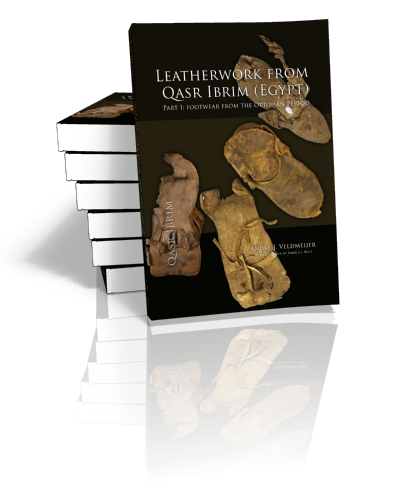Leatherwork from Qasr Ibrim (Egypt)
Part I: Footwear from the Ottoman Period
André J. Veldmeijer | 2013
Throughout its long history, stretching from the 25th Dynasty (c. 752-656 BC) to the Ottoman Period (c. 1500-1811 AD), Qasr Ibrim was one of the most important settlements in Egyptian Nubia. The site has produced…
Sandals, shoes and other leatherwork from the Coptic Monastery Deir el-Bachit
Analysis and Catalogue
André J. Veldmeijer | 2012
Now 50% off!
The Coptic monastery and cemetery Deir el-Bachit stands on the hilltop of Dra’ Abu el-Naga, the well-known necropolis in Qurna (West Bank, Luxor). It is the largest Coptic monastery complex preserved in Western Thebes and…
Amarna’s Leatherwork
Part I. Preliminary analysis and catalogue
André J. Veldmeijer | 2011
The ancient Egyptian city of Tell el-Amarna (or Amarna, ancient Akhetaten) was the short-lived capital built by the controversial Pharaoh Akhenaten, probably the father of the famous Tutankhamun, and abandoned shortly after his death (c.…
Tutankhamun’s Footwear
Studies of Ancient Egyptian Footwear
André J. Veldmeijer | 2011
The discovery of Tutankhamun’s tomb by Howard Carter in 1922 is one of the most significant archaeological discoveries of all time. It took Carter and his team 10 years to clear the contents of the…
Let a cow-skin be brought
Armour, Chariots and Other Leather Remains from Tutankhamun’s Tomb
André J. Veldmeijer & Salima Ikram | Forthcoming
One hundred years ago, Howard Carter, working for Lord Carnarvon, made one of the most important archaeological discoveries of all times in the Valley of the Kings (Luxor, Egypt): the nearly intact tomb of the…
Search results for leather
:
Leatherwork from Qasr Ibrim (Egypt)
Part I: Footwear from the Ottoman Period
André J. Veldmeijer | 2013
Throughout its long history, stretching from the 25th Dynasty (c. 752-656 BC) to the Ottoman Period (c. 1500-1811 AD), Qasr Ibrim was one of the most important settlements in Egyptian Nubia. The site has produced…
Sandals, shoes and other leatherwork from the Coptic Monastery Deir el-Bachit
Analysis and Catalogue
André J. Veldmeijer | 2012
Now 50% off!
The Coptic monastery and cemetery Deir el-Bachit stands on the hilltop of Dra’ Abu el-Naga, the well-known necropolis in Qurna (West Bank, Luxor). It is the largest Coptic monastery complex preserved in Western Thebes and…
Amarna’s Leatherwork
Part I. Preliminary analysis and catalogue
André J. Veldmeijer | 2011
The ancient Egyptian city of Tell el-Amarna (or Amarna, ancient Akhetaten) was the short-lived capital built by the controversial Pharaoh Akhenaten, probably the father of the famous Tutankhamun, and abandoned shortly after his death (c.…
Tutankhamun’s Footwear
Studies of Ancient Egyptian Footwear
André J. Veldmeijer | 2011
The discovery of Tutankhamun’s tomb by Howard Carter in 1922 is one of the most significant archaeological discoveries of all time. It took Carter and his team 10 years to clear the contents of the…
Let a cow-skin be brought
Armour, Chariots and Other Leather Remains from Tutankhamun’s Tomb
André J. Veldmeijer & Salima Ikram | Forthcoming
One hundred years ago, Howard Carter, working for Lord Carnarvon, made one of the most important archaeological discoveries of all times in the Valley of the Kings (Luxor, Egypt): the nearly intact tomb of the…
Browse by subject










